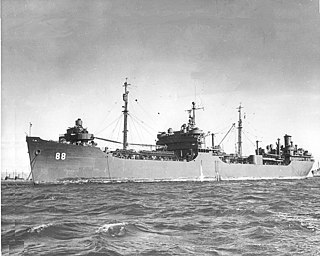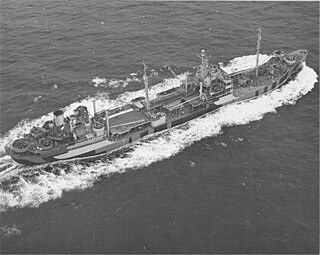
USS Pecos (AO–65) was laid down 20 April 1942 by the Sun Shipbuilding and Dry Dock Co. as a type T3-SE-A1 tanker, Chester, Pennsylvania, as Corsicana ; launched 17 August acquired by the Navy 29 August 1942; and commissioned 5 October 1942.

USS Cimarron (AO-22) was a Cimarron-class oiler serving with the United States Navy and the second ship to be named for the Cimarron River in the Southwestern United States. She was launched 7 January 1939 by Sun Shipbuilding and Drydock Company, Chester, Pennsylvania; sponsored by Mrs. William D. Leahy; and commissioned 20 March 1939.

USS Kaskaskia (AO-27) was a Cimarron-class fleet replenishment oiler serving in the United States Navy, named for the Kaskaskia River in Illinois.

USS Suamico (AO-49) was the lead ship of her class of Type T2-SE-A1 fleet oilers of the United States Navy.

USS Tallulah (AO-50), originally named the SS Valley Forge, was a Type T2-SE-A1 Suamico-class fleet oiler of the United States Navy.

USS Millicoma (AO-73) was a United States Navy fleet oiler which served in the Pacific Theatre during World War II, winning eight battle stars for her dangerous work. Post-war she was recommissioned and was placed under the control of the MSTS with a civilian crew until finally assigned for disposal in 1987.

USS Cowanesque (AO-79) was a Type T2-SE-A1 Suamico-class fleet oiler of the United States Navy during World War II.

USS Kennebago (AO-81) was an Escambia-class replenishment oiler serving in the United States Navy during World War II. Laid down on 9 January 1943, she was named for the Kennebago River located in Rangeley, Maine.

USS Bangust was a Cannon-class destroyer escort in service with the United States Navy from 1943 to 1946. In 1952, she was sold to Peru, where she served as BAP Castilla (D-61). She was decommissioned and scrapped in 1979.

USS Weaver (DE-741) was a Cannon-class destroyer escort in service with the United States Navy from 1943 to 1947. In 1952, she was sold to Peru, where she served as BAP Rodriguez (D-63) until being decommissioned and scrapped in 1979.

USS Lamons (DE-743) was a Cannon-class destroyer escortin service with the United States Navy from 1944 to 1946. She was sold for scrapping in 1973.

USS Mascoma (AO-83) was a Escambia-class replenishment oiler constructed for the United States Navy during World War II. She served her country in the Pacific Ocean Theatre of Operations, and provided petroleum products where needed to combat ships. For her very dangerous work under combat conditions, she was awarded seven battle stars by war's end.

USS Chikaskia (AO-54) was a Cimarron-class fleet oiler acquired by the U.S. Navy during World War II. She served her country primarily in the Pacific Ocean Theatre of Operations, and provided petroleum products where needed to combat ships. For her very dangerous work under combat conditions, she was awarded six battle stars for World War II and one for the Korean War.

USS Marias (AO-57) was a Cimarron-class fleet oiler acquired by the U.S. Navy during World War II. She served her country primarily in the Pacific Ocean Theatre of Operations, and provided petroleum products where needed to combat ships. For performing this dangerous task, she was awarded eight battle stars during World War II, and one campaign star during the Vietnam War for her bravery in combat areas.

USS Chipola (AO-63) was a Cimarron-class fleet oiler acquired by the U.S. Navy during World War II. She served her country primarily in the Pacific Theater of Operations, and provided petroleum products where needed to combat ships. For performing this dangerous task in combat areas, she was awarded three battle stars during World War II and thirteen campaign stars during the Vietnam War.

USS Tomahawk (AO-88) was an Escambia-class fleet oiler acquired by the United States Navy for use during World War II. She had the dangerous but necessary task of providing fuel to vessels in combat and non-combat areas primarily in the Pacific Ocean. For her valiant efforts, she received six battle stars during the war.

USS Sebec (AO-87) was a Escambia-class fleet oiler acquired by the United States Navy for use during World War II. She had the dangerous but necessary task of providing fuel to vessels in combat and non-combat areas primarily in the Pacific Ocean. For her valiant efforts, she received six battle stars during the war.

USS Cahaba (AO-82) was an Escambia-class replenishment oiler acquired by the United States Navy for use during World War II. She had the dangerous but necessary task of providing fuel to vessels in combat and non-combat areas primarily in the Pacific Ocean. For her brave efforts, she received eight battle stars during the war.

USS Anacostia (AO-94) was a Escambia-class replenishment oiler acquired by the United States Navy for use during World War II. She had the dangerous but necessary task of providing fuel to vessels in combat and non-combat areas. She served in the Pacific Ocean Theater of operations late in the war, and returned home with one battle star.

USS Caney (AO-95) was an Escambia-class replenishment oiler acquired by the United States Navy for use during World War II. She had the dangerous but necessary task of providing fuel to vessels in combat and non-combat areas. She served in the Pacific Ocean Theatre of operations late in the war, and returned home with two battle stars.




















